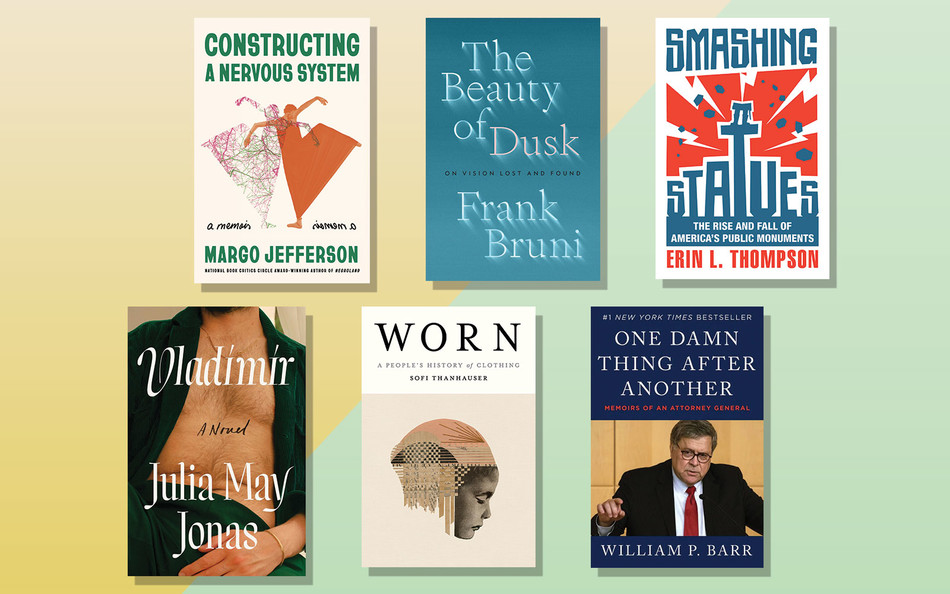Constructing a Nervous System
By Margo Jefferson ’71JRN
In this dazzling follow-up to her standout memoir Negroland, Pulitzer Prize–winning critic and Columbia writing professor Margo Jefferson weaves together her own memories and “raw intimacies” with stories of Black artists who influenced her, including a particularly moving ode to Ella Fitzgerald, whose singular talent was often stymied by the constraints of a racist society. More than just criticism or autobiography, the book is, in her words, an “assemblage [of] recombinant thoughts, memories, feelings, sensations, and words” — a boldly original project with great payoff.
Worn
By Sofi Thanhauser ’06CC
Fashion is often considered frivolous, but Sofi Thanhauser’s riveting social history proves that it is anything but. Rather, as she writes, “there is scarcely a part of the human experience, historic or current, that the story of clothes does not touch.” Thanhauser organizes her book by material — linen, cotton, silk, synthetics, and wool — taking us from the courts of Louis XIV and Marie Antoinette to the homesteads of Colonial America to modern-day Chinese factories. Though she peppers her prose with entertaining anecdotes, the real takeaways from the book are the dire consequences — social, economic, and (increasingly) environmental — that the production of clothing has inflicted throughout history.
One Damn Thing After Another
By William P. Barr ’71CC, ’79GSAS
One of only two attorneys general in history to serve under two different presidents, William P. Barr is uniquely qualified to comment on the current political landscape. In his new memoir, Barr chronicles his experiences working under George H. W. Bush and Donald Trump and delves into issues close to his heart. He is candid about the challenges of the chaotic Trump administration (leading up to his resignation in the final days) though also clear about the ways he feels the president was unfairly targeted. An instant New York Times bestseller, it’s a fascinating window into a turbulent time.
Vladimir
By Julia May Jonas ’12SOA
“When I was a child, I loved old men, and I could tell that they also loved me.” So begins playwright Julia May Jonas’s wickedly funny, deliciously transgressive debut novel, which turns all sorts of things on their heads — especially aging, female desire, and the intersection thereof. When we meet our narrator, she is no longer a child but a fifty-eight-year-old professor at a mediocre liberal-arts school somewhere in upstate New York. Her husband, also a professor, has just been #MeTooed; news of his many dalliances with students has prompted calls for his removal. But our narrator is busy herself, lusting after a new hire: “My prey, my prize, my Vladimir.” Nods to Lolita are, of course, intentional. But Jonas uses the real-life literary Vladimir as a mere launching pad, taking her antiheroine in plenty of unexpected directions.
The Beauty of Dusk
By Frank Bruni ’88JRN
One morning in the fall of 2017, Frank Bruni woke up to find the vision in his right eye blurred. He soon learned that he had suffered a small stroke and that there was a significant chance of losing the sight in his other eye, which would render him completely blind. In his moving memoir, Bruni writes about adjusting to his new normal — one compounded by an unexpected breakup with his longtime partner — and how he manages to find a peaceful, fulfilling way forward.
Smashing Statues
By Erin L. Thompson ’02BC, ’10LAW, ’10GSAS
In recent years, America has become embroiled in a debate about public monuments, particularly those depicting controversial historical figures. Which deserve to stay? Which should come down? And when people take these matters into their own hands, what are the consequences? Erin L. Thompson, who holds both a law degree and a doctorate in art history from Columbia, is an expert in art crime and a consummate guide to these complicated issues. In her carefully researched new book, she takes us through the history of some of America’s most famous statues and provides insight into the current debate.



